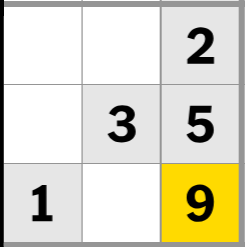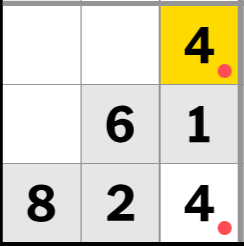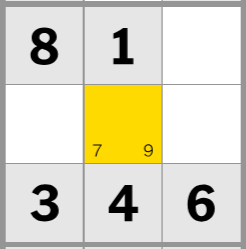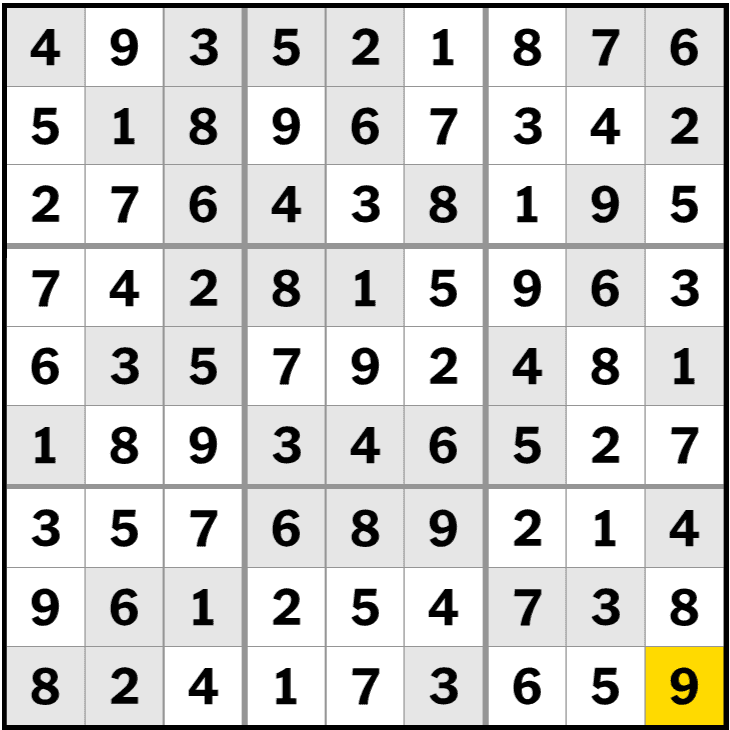The New York Times Games section is known around the world for producing classic word games such as Wordle, Letter Boxed and The Crossword. However, their take on the widely played number logic game, Sudoku, has become the go-to for many players due to its accessibility, clean interface and three different daily levels to choose from.
How to play Sudoku NYT
To play Sudoku, players must fill a 9 x 9 grid by inserting numbers from 1 – 9, making sure that every number played has not already been used within a column or row. In addition, the grid contains 9 blocks (each 3 x 3) which can only contain each number one time.
Each Sudoku puzzle will vary in difficulty based upon the number of starting numbers it gives and their placement. Whereas easier puzzles will have many numbers already filled in, this will not be the case in harder levels, meaning the chances of entering an incorrect number are significantly increased.
1. Before the game begins, players must choose their preferred level of difficulty. In total, the three difficulty levels available are “easy”, “medium” and “hard”.

2. After a puzzle has been selected, players will see the 9 x 9 grid. Study the board and evaluate the columns and rows which have the most numbers filled in. Starting with empty squares from these columns and rows will reduce the number of available numbers to choose from.

3. When you are ready to enter a number, click/tap on a square and it will be highlighted in yellow. Now you can enter your desired number to place it on the grid. The numbers entered can be changed as many times as needed when they have not been checked or revealed.

4. The game will help you by providing feedback if you enter a number which clashes with another already selected in its row, column or block. If this happens, the number(s) that it clashes with will be shown with a red dot in the corner. This is applicable if the number is the same as a starting number or a number input by the player.

5. When you find multiple numbers that can fit inside a square, use the “candidate” button to insert placeholder numbers into the square. This can help for evaluation and can allow players to deduce the correct number to use. Alternatively, to fill these numbers in automatically, players can toggle “Auto Candidate Mode” and each blank square will be filled with all possible candidates.

6. Use the “check” button to see whether a number you entered is located in the correct spot. You can choose to check a cell by itself or check the entire puzzle. Correct numbers will turn blue while incorrect numbers will have a diagonal red line drawn through them. Incorrect guesses can be overwritten.
7. If out of ideas, players can even choose to use the “reveal button” on a cell or for the entire puzzle. Once used, numbers revealed will also change color to blue. Blue numbers can no longer be changed.

8. Once the puzzle has been solved, a pop-up box will appear to congratulate the player and state the amount of time needed for its completion.
For NYT Sudoku, each puzzle is available for just 24 hours. Some players like to revisit puzzles over the course of a day while others look to complete puzzles in one sitting. Once you have mastered the basics, see if you can finish the next one slightly faster or even increase the difficulty level!
Sudoku strategies and techniques
While the concept of Sudoku is easy to understand, accurately choosing the correct number for each square will be the difference between failure and success. With WordsRated’s recommended tips and tricks, now you can take your Sudoku game to the next level!
Choose the correct difficulty – Most Sudoku levels state their difficulty, which can be a great advantage to players. Each time you decide to start a new puzzle, make sure its difficulty is equal to your skill level. However if you found the last puzzle too easy, you should consider raising the bar slightly. This way you will always face a new challenge and you can get better at the game.
Regular practice – Even if Sudoku seems hard at first for many players, playing it with regularity should see players rapidly improve their ability. Constant exposure to games of varying difficulties can help you identify new solving methods and as it is a one-player game, each player can play at a pace that suits them under little pressure.
Track candidates – When attempting to solve a Sudoku puzzle, it is important to track the different candidates for unanswered squares. If only one candidate can be found for an empty square, you will know that it is the correct answer. However, if multiple candidates can be found, they should be noted and assessed later. When assessing squares with multiple candidates, players should compare against other squares in the same column, row or block.
Scan when stuck – Players can often hit a dead end when playing Sudoku and attempt playing numbers in an incorrect spot out of haste. Instead of doing this, keep on scanning all available candidates until all unanswered squares have been analyzed. Using this information, you may be able to find a new number to play, opening up new possibilities for following moves.
Learn special strategies – Once players have developed past the beginner phase, they should look to develop their game by being able to identify and use intermediate and advanced strategies, including:
- Naked candidate(s): The only possible placement for a digit or digits in a column, row or block.
- Hidden candidate(s): The only possible placement for a digit or digits in a column, row or block, although their cells may not be obvious immediately because of other candidates.
- Locked candidate(s): Restricts the placement of a digit or digits to a column, row or block while excluding other units from containing the digits(s).
- X-wing: The same number is only possible in exactly two positions within two columns or rows, forming the shape of a rectangle. The digit can then be eliminated from other columns or rows that intersect it.
- Y-wing: When three cells each have two candidates. These combine to form strong and weak links that can result in a candidate from a fourth cell being eliminated.
- Swordfish: The identification of three columns or rows where a candidate number can only appear in three cells, which forms a pattern that looks similar to a fish.
Use time wisely – Although many of the most popular and recognized Sudoku puzzles do not have time limits, there are others that are daily games like Wordle, giving players a limited time to find the solution. If you tend to play Sudoku with a time limit, try to dedicate sufficient time to solve levels in one sitting, or split out your time to find the solution over the course of a day.
Difficulty levels for NYT Sudoku
We can assess the difficulty of each of the three NYT Sudoku difficulty levels by looking across four different areas: number placement, grid symmetry, logic strategies and trial & error.
NYT Sudoku easy
- Number placement: Many numbers are provided in places that will make it easier for players to complete the grid.
- Grid symmetry: Easy puzzles often display a high amount of grid symmetry.
- Logic strategies: Requires the use of basic strategies such as single candidates and naked singles.
- Trial & error: Minimal or no level of trial and error is required by the player.
NYT Sudoku medium
- Number placement: Fewer numbers are provided than in easy mode, requiring additional deductive reasoning to complete the grid.
- Grid symmetry: Medium puzzles often display a fair amount of grid symmetry.
- Logic strategies: Requires the use of intermediate strategies such as naked pairs/triples, hidden singles and forcing chains.
- Trial & error: Trial and error may be required by the player occasionally.
NYT Sudoku hard
- Number placement: Fewer numbers are provided than in easy mode and players will need to show extremely careful analysis to complete the grid.
- Grid symmetry: Hard puzzles often display a minimal or even no level of grid symmetry.
- Logic strategies: Requires the use of advanced strategies such as X-wings, Y-wings and Swordfish.
- Trial & error: Trial and error will be required by the player frequently.
Is Sudoku good for your brain?
Sudoku has been linked to improved concentration, memory and brain health as players are required to demonstrate pattern recognition and logical reasoning as they solve each puzzle. When practiced with regularity, Sudoku can be a great way to give your brain a workout and have fun while doing so.
NYT Sudoku game settings
The NYT Sudoku has five different settings that can be toggled on or off, according to the preferences of each player.
- Check guesses when entered (default: off)
- Start in automatic mode (default: off)
- Highlight conflicts (default: on)
- Play sound on solve (default: on)
- Show clock (default: on)

